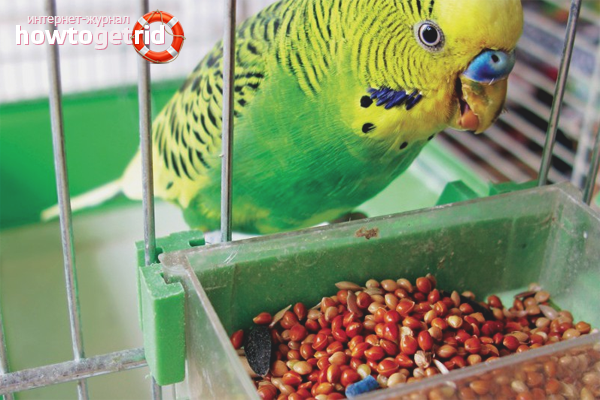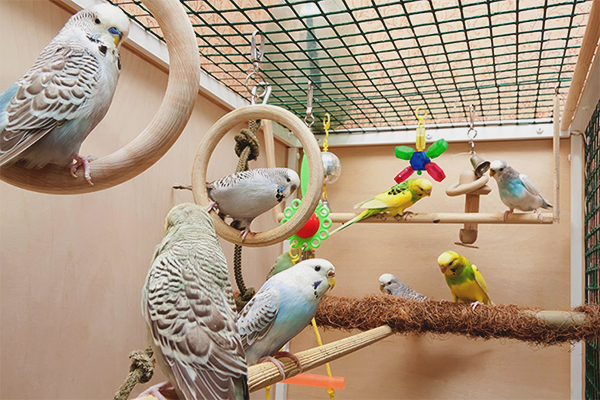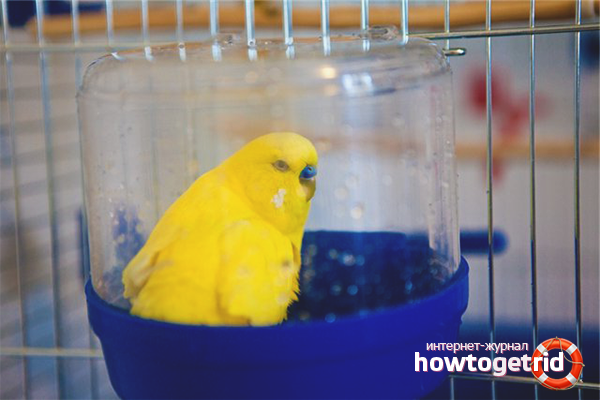The content of the article
When starting an animal or bird at home, a person should bring the pet’s living conditions as close as possible to the natural ones. This concerns the diet of pets, and most importantly - the conditions of their maintenance. The size, as well as the filling of the cage, play an important role in the care of the parrot. The baby will live in this space all the time, so it needs to be made comfortable, comfortable and safe.
Cage for a parrot
Choose a sufficiently spacious cage so that the birds (if there are several of them) are able to fly freely from one perch to another without touching the wings of the rods. The cage must be larger in width than in height. The optimal cage size for a parrot is 60-30-30 centimeters. If the cage is very small, the bird will fly a little, will gain weight, and may even get sick. At the same time, it is very important not to place the pet in an overly spacious cage - a large space prevents the domestication of the bird.
Pay attention to the cell door. They should open freely and close tightly. Choose serious valves to prevent the parrot from opening them yourself. If the bird gets out, it can get hurt. In addition, the door itself should be wide so that you can take out your hand with a parrot through it. After all, you have to take the bird in hand, carry it to the vet, etc.
Cage with a pet is better placed in the common room, for example, the living room. It should be a warm enough (but not hot) room without too much moisture. The cage should not be placed in direct sunlight, near electrical appliances and heaters. Also the cage should not be located in a draft or near the bathroom,otherwise the bird will often catch cold. At night, the cage is covered with a thick cloth so that the bird understands that it is time to rest. And in order for the pet to feel good, the cage must be properly equipped.
What should be in the cage
The wavy parrot is an unpretentious bird, but the cage must have everything that a feathered bird may need. It is very important to find the optimal balance - to install everything you need, but not to force the cage with unnecessary objects, cluttering up the free space. So, the list of necessary "furniture" for a cage with a parrot.
Perches
The bird spends most of its time on the perch, so they need to be taken care of first. The pole may be complete with a cage, but often it is made of plastic. A smooth surface can cause corns to form on the legs of the bird. On sale there are special poles with sandpaper, which are designed to grind claws. Such poles are better not to install, they damage the delicate skin of the legs of the bird. It is best to choose wooden poles, 1.5-2 cm in diameter.The crossbars can be made from apple, birch, maple, alder or plum wood. But the wood of oak, chestnut, elm, walnut, bird cherry, poplar and lilac is not suitable for such purposes. Poles should be 2, set them opposite each other. Even if the bird lives alone, it will allow the parrot to fly from one pole to another, flexing its wings. The distance should be such that the bird when sitting on the perch does not touch the tail of the rods of the cage. Poles should be installed tightly, they should not swing or spin.
Manger

The feeder is a container of plastic or ceramic, which is mounted on the bars of the cage. Ideally, the bird should have three feeders. The first - for dry food, that is, grain. There must always be food in it, since wavy parrots have a fast metabolism and cannot stretch for a long time without food. On the day the parrot needs about 1.5-2 teaspoons of grain. The second feeder is designed for the mineral composition, which is necessary for the bird to maintain health. Indeed, in nature, the food of a parrot is much more diverse. At home, wavy minerals offer minerals so that they do not experience a deficiency in vitamins.The third trough is designed for cereal, fresh vegetables and fruits. Some parrots love to eat vegetables only in shredded form. Others, on the contrary, prefer to peck only whole fruits and vegetables. For such gourmets, instead of a feeder, you can install a special holder for fruit. He pinches the fruit, and the bird eats it with pleasure. Do not use automatic feeders. First, some birds are wary of the mechanism and the unfamiliar sound, and therefore do not eat from them, even with strong hunger. And secondly, automatics can break down, and the bird will be left without food until you arrive.
Drinking bowl
Placing a simple bowl of water in the cage is wrong. The fact is that the bird can overturn the cup, the water will spill and the parrot will remain without water. In addition, high humidity for birds is extremely undesirable. Automatic drinkers always serve clean water, they are fixed on the bars of the cage. If you have a parrot or a couple of them, one drinker is enough. But for three individuals and more need a few troughs.
Mineral stone, chalk or pumice
One of these items must necessarily be in a bird cage.A hard object is necessary for a parrot to grind off its beak and claws.
Toys
Sprigs
In the cage of a parrot should always be tree branches. They serve as a toy for the parrot, the bird trains and sharpens its beak about them.In addition, the parrot receives a certain portion of nutrients from fresh wood. Do not leave branches of conifers in a cage, they are harmful to bird health.
Paper
Paper is put in the tray to absorb unpleasant odors and waste of poultry. In no case do not use newsprint - printing ink is quite aggressive, and can lead to skin diseases of poultry.
Kupalka
If the cell is large, if desired, you can install a special bathing in it. It is a plastic box, at the bottom of which a small amount of water is poured. Kupalka attached to the bars of the cage. Parrot climbs into the bathing room, and with pleasure indulges in water procedures. Instead, you can set at the bottom of the cage a cup with sand in which the bird will “flush” its wings.
Among the rules for the location of objects in the cage can be noted that the drinking bowl and the feeder should not be located next. They must be installed at different ends of the cage - so you stimulate the parrot to motor activity. And you do not need to install feeders and drinkers under the poles to prevent droppings from getting into the food and water.
Wavy parrots are one of the most intelligent, talkative, affectionate and tamed birds.Caring for a wavy parrot is pretty simple. Provide your pet with all the necessary attributes for life, regularly devote his time to him, and he will answer you with love and full of songs.
Video: how to choose a cage for a wavy parrot












To send